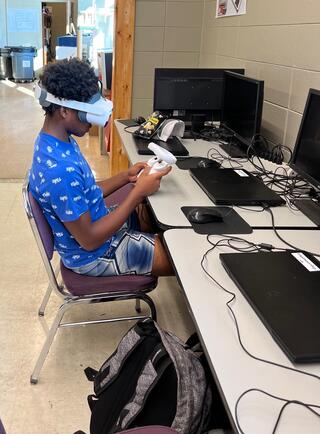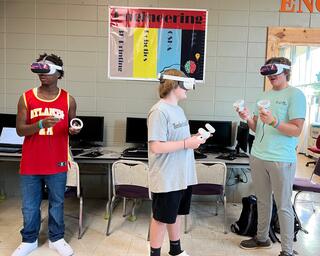
Bailey Dumas and Hayden Yandell
By Debbie Burt Myers
Virtual Reality Technology is coming to classrooms in the Neshoba County School District and administrators and teachers could not be more excited.
Neshoba Central purchased 35 virtual reality headsets for students to use across the district from pre-kindergarten to 12th grade. More will be added in the future.
Students will be able to access such things as virtual reality anatomy labs, Independence Hall and a nuclear power plant. In addition, there is the periodic table, the solar system and ancient Egypt among numerous other areas of virtual studies.
Through the Immersive Institute, powered by Lobaki Inc. of Jackson, students will have an extensive library of virtual reality experiences in all grades. The content is fully engaging and allows for interactive experiences across a wide range of curriculum content areas.
Lundy Brantley, Neshoba County Superintendent of Education, said Toyota and Nissan already use virtual reality technology to train their employees as well as the healthcare industry.
“It’s kind of like the airplane industry,” Dr. Brantley said. “You don’t stick a pilot in the cockpit on day one. They go to a simulator.”
Dana McLain, director of work-based learning at Neshoba Central, said the virtual reality curriculum “is going to be a different way of learning” for Neshoba Central students.
“They are going to learn digitally,” she said. “Students will be able to access a curriculum from elementary to high school.”
McLain along with other administrators and teachers joined Lobaki’s representatives for a recent training session where they toured a power plant and a human anatomy lab virtually after designing their own individual avatars.
“During our training at the lab we were able to dissect, putting bones together from cadavers with an instructor,” McLain said. “It was really neat that we were all in an operating room together.”
McLain said virtual reality allows students to learn at a different level.
“We learned through our training session that business and industry are training their employees through virtual reality technology such as this,” she said. “Instead of students learning to physically drive a forklift, we can teach them virtually through this technology. They remain safe and it is cost effective.”
One of the main reasons the school district purchased the new technology is for student engagement.
Neshoba Central will introduce the new program initially through career technology.
“We’re starting small,” McLain said. “They will have access first and foremost.”
Two middle school teachers in the training session plan to initiate the virtual reality technology with career exploration.
The agriculture teacher wants to use virtual reality learning in his introduction to agriculture classes for safety reasons.
Engineering instructors and JROTC instructors are also making plans to use the new technology.
As they become more knowledgeable about it and use it more fluently, plans are to open the virtual reality technology to pre-k and elementary students, including those enrolled in special education.
“Moving into the future, we want to get as many of these virtual reality headsets as we can in students’ hands,” McLain said.
Dr. Brantley was quick to note that the new virtual reality headsets are not toys, although they provide fun and exciting instruction.
“This is what they use in business and industry and it’s becoming more and more prevalent because it is more cost effective,” he said. “That is where we are and where we are going. These are real world instruments being used by some of the largest corporations in the country.”
Dr. Brantley is especially excited that the technology will be used by students for career exploration.
“We’ve got so many kids who think they want to do something after graduation because it sounds good but they don’t really know exactly what it is,” he said. “This will give them a better opportunity in a short period of time to explore careers. They will be able to make better decisions about what they think they like or what they think they don’t like.”
One part of the curriculum takes the student on an oil rig.
“Now a student who thinks he wants to work on an oil rig can actually see what that entails,” Dr. Brantley said. “Quite frankly, most people, who go out there to work, see the rigs for the first time. They don’t really know what to expect. This will give them a better idea of what a rig is really like.”
Emanual Moore
 Jae’len Clemons, Hayden Yandell and Bailey Dumas
Jae’len Clemons, Hayden Yandell and Bailey Dumas
